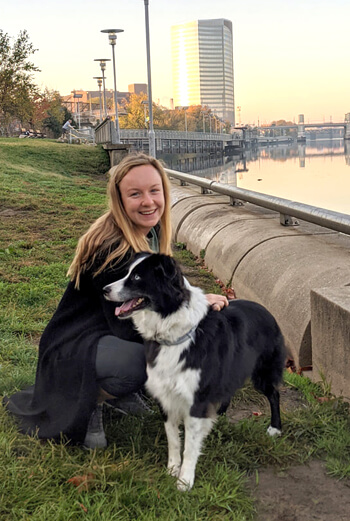 Lauren Powell, pictured with Ebby, a friend’s dog,
Lauren Powell, pictured with Ebby, a friend’s dog,
studies the human-animal bond.
Nationwide, there are far more dog owners today than before the COVID-19 pandemic began. Many are novice dog owners, navigating care and training of their canine companions for the first time.
According to Lauren Powell, a postdoc at Penn’s School of Veterinary Medicine, the pandemic hasn’t been an easy time to jump into the waters of dog ownership.
The advice during the pandemic was, ‘Don’t interact with strangers, don’t leave your house unless you have to,’” she says. “But for people who acquired puppies during this time, normally the advice would be the opposite: to introduce them to new situations, new dogs, and new people.” That lack of socialization can lead to dogs that fear strangers or new scenarios.
Another looming challenge is separation anxiety for pets that have gotten used to their owners’ constant presence. “I think it’s important to understand that, if folks have to head back to school or work, this is going to be a period of change for their dogs, and it might be uncomfortable,” Powell says.
Yet research by Powell and Penn Vet colleagues aims for the relationship between dogs and humans to be more calm, joyful, and fulfilling for both parties.
In a study of dogs and dog owners published earlier this year, Powell and Penn Vet coauthors James Serpell, Carlo Siracusa, and Darko Stefanovski found that it's not only the dog’s temperament that makes a difference in how well a dog responds to training; it’s the owner's personality type as well.
The study, in the journal Frontiers in Veterinary Science, looked at dogs that visited Penn Vet’s Behavior Medicine Service. “These are dogs with, in most cases, severe behavior problems,” Powell says.
The goal was to look at the dogs’ responses to interventions guided by veterinary behavioral specialists and carried out by the owners themselves. Owners completed a survey three times during six months about their perceptions of their pet’s behavior; the Canine Behavior Assessment and Research Questionnaire, or C-BARQ, developed by Serpell, has been used in numerous studies in the last two decades. They also filled out a 10-question survey about their own personality and answered questions about their attachment to their pet.
While the researchers were not surprised that the personality of owners had an influence on the dogs’ outcomes, the nuances of those effects were in some cases unexpected. Owners that were more introverted according to the personality survey, for instance, saw less improvement in their dogs’ fearful behavior.
“There are lots of reasons why the owner’s personality may affect the dog,” Powell says, “but a possible explanation is that, perhaps introverted owners are more reliant on their dogs for companionship and less willing to give a dog space if the dog is fearful or not does not want to be comforted or petted.”
More extroverted owners, on the other hand, and those who reported strong attachment to their dog were more likely to find training success.
Interestingly, owners who scored as more conscientious on their personality survey saw less improvement in their dogs’ aggression. “That was originally surprising to me,” says Powell. “But one of the things that Carlo suggested was that especially conscientious owners might be more aware of their dogs’ aggressive behavior and would thus be more likely to report minor changes and try to manage them, while less conscientious owners may only report major changes and may think the dog is improving when some of the problems are still there.”
Some of the findings upheld previously understood notions of dog behavior. The team found, for example, that older dogs tended to show less improvement in behavior than younger dogs. “That just speaks to how important it is to address behavioral problems early on,” Powell says. “At the same time we don’t want to say that older dogs can’t improve because we see that they can.”
The work complements Powell’s earlier research, for her Ph.D., which looked at the human side of the human-dog relationship, including the effects of dog ownership on owners’ mental and physical health. “We see that every member of a household can be affected differently by the presence of a dog,” says Powell, “depending on their strength of attachment, their role in owning the dog, and the dog’s behavior toward them.”
Going forward, Powell and her colleagues aim to continue looking at animal—and owner—welfare from both sides, human and canine, with studies on how owner expectations affect their experience with their dogs and how dogs’ behavior changes in the days and weeks after adoption as they settle into a home.
Many of her current studies, through Penn Vet’s Shelter Medicine program, have been shaped by the pandemic, looking at the challenges animal shelters have faced and the factors that contribute to the possibility an adopter might return an animal to the shelter.
“There has been a fear that we’ll see increased relinquishments, whether it’s due to behavioral challenges, housing insecurity, or fear of zoonotic transfer of COVID-19, but so far we haven’t seen a major uptick,” Powell says.
For those pet owners anxious about behavioral challenges, especially with changing routines upon returning to in-person work and school, Powell says providing enrichment can keep pets mentally active and avoid boredom. “Any sort of shared activity that the owners and dogs like doing is great,” Powell says. And to avoid concerns about separation anxiety, “taking it slow” is Powell’s advice. “Try to develop a routine, get the dog used to you leaving home, and perhaps increase the time you’re apart steadily and you’ll reduce the likelihood of real concerns.”
Barring that, help is out there.
“If owners are really having problems, the main thing is to ask for help,” says Powell. “Reach out to a vet or to a local behavioral specialist.”
Lauren Powell is a postdoctoral researcher in the School of Veterinary Medicine at the University of Pennsylvania.